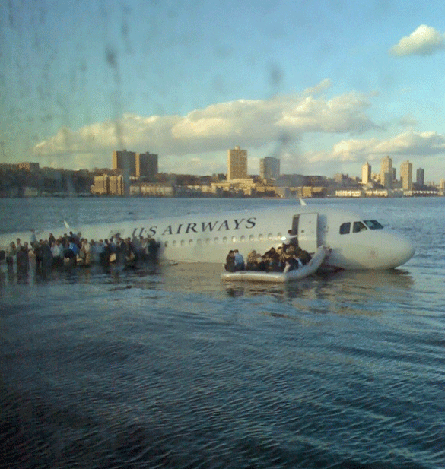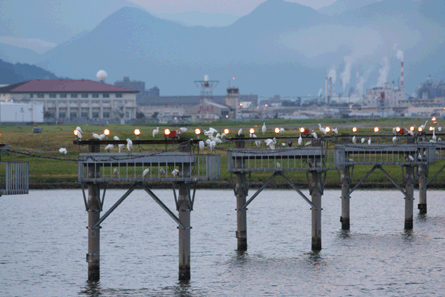Assuming the US Airways Airbus A320 ditched in New York's Hudson river two weeks ago proves to have been brought down by Canada geese, the incident will still be only the most serious of numerous birdstrikes in the past year.
But regardless of the astoundingly fortunate outcome, a renewed industry focus on tackling what has proved to be an enduring challenge for civil aviation seems certain.
It is a tribute to sound regulatory action and manufacturers' engineering expertise that modern engines have proved to be so resilient when struck by birds. Despite that, the hazard generates huge costs even when aircraft survive, and there have been sufficient close calls to leave little doubt that a catastrophe is a reasonably likely turn of events.
Just two months earlier a Ryanair Boeing 737-800, also CFM56-powered, barely made it to a landing that collapsed the landing gear when both engines lost virtually all power after ingesting a number of starlings from a flock that engulfed it at about 200ft (60m) above ground on short finals to Rome Ciampino.
A month earlier a Cyprus Airways Airbus A330 flew from Larnaca, Cyprus to London despite having ingested birds into both engines on departure.
A recent report from the French government and civil aviation authority DGAC noted that 700 birdstrikes occur in the country each year, including 20% considered "significant" in terms of damage, cost or safety. It records a Boeing 767 incident in 2007 in which the ingestion of three herring gulls generated a €4 million ($5.17 million) repair bill.
 |
|---|
© Janis Krums |
Major UK airport operator BAA has adopted a strategy of concentrating its bird-control effort on those species that are most prevalent and/or most likely to cause the worst damage. It is pleased with the results, which have seen such incidents at its seven locations fall steadily from 108 in 2004 to 71 in 2007, but still totalled 44 by the end of August last year.
John Allan, head of the birdstrike avoidance team at the UK Department of Environment, Food and Rural Affairs Central Science Laboratory (CSL) and chairman of the International Birdstrike Committee (IBSC), says BAA's flagship Heathrow operation is a global industry leader with fewer than 1 strike per 10,000 aircraft movements. "There are European airports with rates of more than 10 per 10,000 movements," he says.
UK CAA figures reveal a total civil birdstrike number for the nine months up to September 2008 as being more than 1,200, although the advent of mandatory reporting in the UK in 2004 drove the number of recorded incidents up dramatically - many of them minor.
The US Federal Aviation Administration reported more than 33,000 civil birdstrikes between 1990 and 2000, and the figure now runs at 7-8,000 a year as reporting has been tightened up.
Airbus's analysis of in-service reports suggests that two out of three birdstrikes result in a delay of upwards of 90min due to checks being carried out, plus repairs if required. The manufacturer says that incidents on take-off or climb-out result in a one-in-three likelihood that the flight will not continue to its planned destination. But it adds that approach incidents, probably due to low power settings, are more benign, and in one recorded case at a maritime airport an Airbus A320 flew through a flock of birds without ingesting any but leaving 250 dead birds on the tarmac.
KNOW YOUR ENEMY
Much of the best practice in bird control is now widely accepted and implemented with local variations according to native species and habitat. Relatively long grass - 15-20cm (5.9-7.8in) in the UK - is the norm, covering of storm ponds and other standing water with wire grids or floating balls for smaller areas is common, and planning regulation to restrict the development of waste disposal and gravel digging near airports is in global use to varying degrees.
Technological solutions are less common, but the past couple of years have seen a growing interest in the use of high-resolution radar to track birds. The systems entering service are typically enhanced versions of commercially available maritime radars, mechanically scanned and either X-band or S-band, but with sophisticated signal processing added.
 |
|---|
© KPA Zuma/Rex Features |
Dr Tim Nohara, president of Niagara, Ontario-based Accipiter Radar Technologies (ARTI), says the systems are able to resolve targets down to individual birds. He explains that the benefit of radar is that it gives all-weather, day and night surveillance of local bird activity in a way that human observers cannot achieve.
Additionally it provides real time and recorded historic data for subsequent analysis including location, height, speed and heading.
This is crucial as a "force multiplier" when implementing classic "habitat modification" techniques he says. "Avian radars allow you to measure the efficiency of these methods. The fact of the matter is that now they use humans periodically to sample it, but at night time there is virtually no data and it is very sparse by day."
Under a US FAA Center of Excellence for Airport Technology (CEAT) programme, ARTI has systems running at Seattle Tacoma International and Chicago O'Hare, plus another at Kennedy International, which is delivered but not yet operational.
"This is putting radars into candidate airports and really understanding what they give you and understanding their limitations. And that moves to the second part, which is to see how would controllers and wildlife experts and so on use this tool," says Nohara.
He notes that the US Airways accident has sparked interest in the possibility of using the radar data in real time to provide live avoiding information to controllers. Intriguingly, he says recent ARTI work designed to capture data on near-misses as well as the much rarer birdstrikes demonstrated that real-time data could be captured.
He cautiously suggests: "This is the most futuristic use - but you can imagine an advisory from an avian radar that there are some movements in such an area that might get into conflict with aircraft. The technology is available and could provide that kind of indicator, but more work needs to be done to see how effective that might be."
More realistically for now he sees the radars as being of enormous use to under-resourced airport wildlife staff. A biologist arriving for work could fast-forward through the night-time radar recording and watch where the birds have roosted.
 |
|---|
And by collating historic data it will be much easier to identify local problem areas, such as standing water.
He foresees radar being used in Europe, where the use of safety management systems is more widespread, to give airport management an accurate measure of return on investment in bird-control programmes.
Detect, of Panama City, Florida, which supplies the "Merlin ATC" radar system, relates an incident in which a single bird that hit an aircraft caused a runway at Kennedy International to close for 6min on an otherwise free-flowing day, resulting in an immediate air traffic back-up.
"A radar-indicated hold of 30s for a bird to clear the runway may be more acceptable in terms of traffic management than a 6min delay when a strike has occurred, and tools such as Merlin ATC could provide much improved situational data to airport personnel to support sound decision-making," it says.
In Europe, Amsterdam Schiphol airport will shortly begin using the Robin Lite radar system developed by the Netherlands' TNO research and development organisation. Senior project manager Addy Borst says the system is already in use with the country's air force and has cut the service's birdstrike rate by a remarkable 50%, although the commercial priorities at civil airports may make similar gains difficult to achieve.
Robin Lite has the claimed capability to analyse wing-beat patterns of individual birds in a flock which, says Borst, gives an indication of size and hence species – potentially useful information.
He explains: “Some birds are not really an issue for birdstrike protection because they are smart enough to get away. Ravens, for example, learn quite fast. But gulls and pelicans are quite stupid birds. So birdstrike protection people would like to know what kind of birds to approach.”
He also believes that there is the potential for air traffic controllers to use data in realtime, but suggests that that in turn raises a legal issue. He says: “Controllers could be informed when you see a swarm of birds approach and can see that their trajectory will take them into conflict with aircraft, and then you could halt take-offs for say 30 seconds.
“But then if they decide to give take-off clearances instead then there is a liability issue.” It is not a theoretical issue – airports have already paid out large sums to airlines in liability settlements following birdstrikes.
NOT CHEAP
In the UK, CSL's Allan points to resource constraints as a key factor. He says: "In essence we know what needs to be done. We have enough knowledge about bird management and bird-scaring techniques to keep it under control. But some of this work is not cheap. Managing an airfield to make it unattractive to birds is very expensive and if you are one of the smaller airports this is an issue.
"Heathrow has two [bird control] vehicles out all day and it is do-able. The difficulties arise when you have to find a budget to do this work."
The result, he says, is that many airports tend to focus on bird-scaring, which is successful in the short term, but undertake inadequate habitat-management work, which would yield better long-term results.
He is also unhappy with the degree of research being performed in the UK, noting that, through lack of data, "we really don't understand how to do bird control at night" despite probably having the technology to do it.
And he worries that the industry is failing to keep up with the evolving threat, notably by still using techniques aimed at controlling lapwings, formerly the prevalent species of concern in the UK, when pigeons, which require a different approach, are now by far the biggest threat.
See Kieran Daly's blog for pictures of a particularly messy birdstrike.
Source: Flight International























